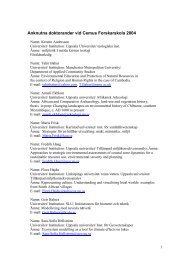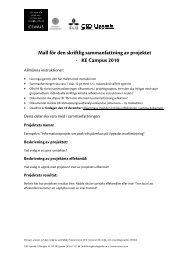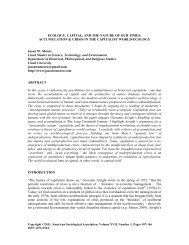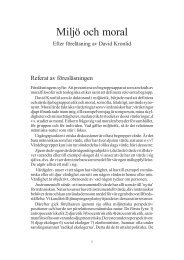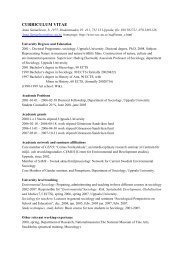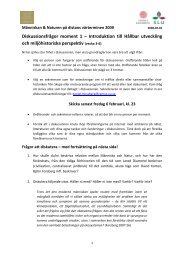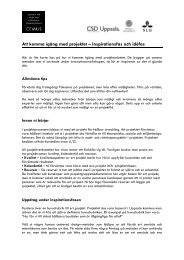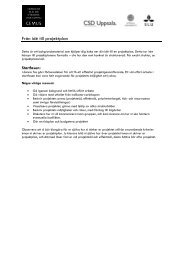Benefits of genetically modified crops for the poor - entsteht die ...
Benefits of genetically modified crops for the poor - entsteht die ...
Benefits of genetically modified crops for the poor - entsteht die ...
You also want an ePaper? Increase the reach of your titles
YUMPU automatically turns print PDFs into web optimized ePapers that Google loves.
REVIEW New Biotechnology Volume 27, Number 5 November 2010ReviewTABLE 2Comparative advantage <strong>of</strong> Bt over conventional cotton in India.2002 2004 2006 AverageInsecticide use 50% 51% 21% 41%Yield +34% +35% +43% +37%Seed cost +221% +208% +68% +166%Total cost +17% +11% +24% +17%Gross revenue +33% +37% +40% +37%Pr<strong>of</strong>it +69% +129% +70% +89%Pr<strong>of</strong>it gain in US$/ha +111$ +142$ +152$ +135$Source: [5].area. Most <strong>of</strong> <strong>the</strong> cotton farms are small-scale, especially in centraland sou<strong>the</strong>rn India. The average size <strong>of</strong> Bt-adopting farms is lessthan 5 ha, with an average cotton area <strong>of</strong> about 1.5 ha. There<strong>for</strong>e, acloser look at <strong>the</strong> impacts in India is particularly interesting.Table 1 shows cotton enterprise budgets in India with andwithout Bt technology <strong>for</strong> three growing seasons between 2002and 2006. The data were collected from randomly sampled farmsin four states and are representative <strong>of</strong> India’s smallholder-dominatedcotton production systems [3]. The results are summarisedin Table 2. In all three seasons, <strong>the</strong> number <strong>of</strong> insecticide spraysand insecticide amounts used were significantly lower on Bt thanon conventional plots. The exact reductions vary from year toyear, which is partly due to seasonal variations in pest pressure.Moreover, owing to increasing adoption <strong>of</strong> Bt over time, target pestpopulations declined, so that even conventional cotton growerscould reduce <strong>the</strong>ir insecticide sprays considerably in recent years.Average reductions in insecticide use through Bt technology were41% over <strong>the</strong> three growing seasons. These reductions occurmostly in highly toxic chemicals, so that Bt cotton is also associatedwith significant benefits <strong>for</strong> <strong>the</strong> environment and farmers’health.In addition to insecticide reductions, a major effect <strong>of</strong> Bt cottonin India is a sizeable yield advantage due to lower crop losses, aspreviously predicted by Qaim and Zilberman [4]. Over <strong>the</strong> years,average yields were 30–40% higher on Bt than on conventionalplots, which is due to more effective pest control and thus areduction in crop damage. Again, differences over <strong>the</strong> years arelargely due to variability in pest pressure. Regression analysesconfirm <strong>the</strong> gains in effective yields through Bt even after controlling<strong>for</strong> differences in input use and o<strong>the</strong>r factors [3,5]. Higheryields and crop revenues are also <strong>the</strong> main reasons <strong>for</strong> <strong>the</strong> significantgains in cotton pr<strong>of</strong>its, in spite <strong>of</strong> higher seed prices. Pr<strong>of</strong>itdifferences between Bt and conventional cotton even increasedover time, which is partly due to seed price caps that state governmentshave introduced since 2006. Over <strong>the</strong> three seasonsobserved, mean pr<strong>of</strong>it gains were in a magnitude <strong>of</strong> 89%, or 135US$ per ha. These are large benefits <strong>for</strong> cotton-producing householdsin India, many <strong>of</strong> whom live near or below <strong>the</strong> poverty line.Extrapolating <strong>the</strong>se pr<strong>of</strong>it gains to <strong>the</strong> total area under Bt cotton inIndia (8.4 million ha) implies an additional 1.13 billion US$ peryear in <strong>the</strong> hands <strong>of</strong> smallholder farmers.In spite <strong>of</strong> this evidence, which is also confirmed in o<strong>the</strong>r stu<strong>die</strong>s[6,7], <strong>the</strong>re are widespread public concerns that smallholder farmerswould not benefit from Bt and that <strong>the</strong> technology wouldra<strong>the</strong>r cause economic and social problems among <strong>the</strong> <strong>poor</strong> [8].What <strong>the</strong> mean values discussed above (Tables 1 and 2) mask isthat <strong>the</strong>re was considerable impact variability in <strong>the</strong> early years <strong>of</strong>Bt cotton adoption. Especially in 2002, <strong>the</strong>re were some farmers incertain regions who did not pr<strong>of</strong>it, due to insufficient in<strong>for</strong>mationon how to use <strong>the</strong> technology successfully. Moreover, only a smallnumber <strong>of</strong> Bt varieties were available, which were not suitable <strong>for</strong>all agroecological conditions [3,9]. These initial problems wereovercome, however, as is reflected in <strong>the</strong> rapid and widespreadaggregate adoption.Income distribution and poverty in IndiaBeyond <strong>the</strong> direct effects on crop pr<strong>of</strong>its <strong>for</strong> adopting farmers, newtechnologies such as Bt cotton also entail indirect effects throughbackward and <strong>for</strong>ward linkages to o<strong>the</strong>r markets. For instance,higher cotton yields through Bt provide more employment opportunities<strong>for</strong> agricultural labourers and a boost to rural transport andtrading businesses. Income gains among farmers and farm workersentail higher demand <strong>for</strong> food and non-food items, inducinggrowth and household income increases also in o<strong>the</strong>r local sectors.Such indirect effects were positive and large <strong>for</strong> Green Revolutiontechnologies in <strong>the</strong> 1970s and 1980s [10]. Related stu<strong>die</strong>s <strong>for</strong> GM<strong>crops</strong> have hardly been carried out. One exception is Bt cotton inIndia, <strong>for</strong> which wider rural development effects have been analyzedby Qaim et al. [11] and Subramanian and Qaim [12]. Theresults <strong>of</strong> this research are summarised in <strong>the</strong> following.Using detailed census data from a typical cotton-growing villagein central India and building on a social accounting matrix (SAM)multiplier model, <strong>the</strong> total income effects <strong>of</strong> Bt cotton wereestimated. These effects not only incorporate <strong>the</strong> direct benefits<strong>for</strong> cotton farmers in terms <strong>of</strong> higher pr<strong>of</strong>its, but also include <strong>the</strong>indirect effects that occur in o<strong>the</strong>r markets and sectors. Overall,each ha <strong>of</strong> Bt cotton creates aggregate incomes that are 246 US$higher than those <strong>of</strong> conventional cotton (Figure 1). For <strong>the</strong> totalBt cotton area in India, this translates into an annual rural incomeFIGURE 1Income effects <strong>of</strong> Bt cotton in comparison to conventional cotton in ruralIndia.Note: The results shown include direct benefits among cotton farmers as wellas indirect effects through backward and <strong>for</strong>ward linkages with o<strong>the</strong>r ruralmarkets and sectors. For <strong>the</strong> evaluation <strong>of</strong> income distribution effects,households were disaggregated using local poverty lines, which are very nearto <strong>the</strong> World Bank’s thresholds <strong>of</strong> 1 and 2 US$ a day (purchasing power parity)<strong>for</strong> extreme and moderate poverty, respectively. Source: [11].554 www.elsevier.com/locate/nbt
New Biotechnology Volume 27, Number 5 November 2010REVIEWgain <strong>of</strong> 2.07 billion US$. Considering that <strong>the</strong> direct pr<strong>of</strong>it gains <strong>for</strong>Bt cotton farmers are in a magnitude <strong>of</strong> 1.13 billion US$ (seeprevious subsection), it can be concluded that each dollar <strong>of</strong> directbenefits is associated with about 83 cents <strong>of</strong> additional indirectbenefits in <strong>the</strong> local economy.In terms <strong>of</strong> income distribution, all types <strong>of</strong> households benefit,including those below <strong>the</strong> poverty line (Figure 1). 60% <strong>of</strong> <strong>the</strong> gainsaccrue to <strong>the</strong> extremely and moderately <strong>poor</strong>. Bt cotton is also netemployment generating, with interesting gender implications:compared to conventional cotton, Bt increases aggregate returnsto labour by 42%, while <strong>the</strong> returns <strong>for</strong> hired female agriculturalworkers increase by 55%. This is largely due to additional labouremployed <strong>for</strong> picking cotton, which is primarily a female activityin India [12]. As is known, women’s income has a particularlypositive effect <strong>for</strong> child nutrition and welfare [13].These results on income distribution cannot be simply extrapolatedto o<strong>the</strong>r regions and o<strong>the</strong>r GM technologies, as impactsalways depend on <strong>the</strong> conditions in a particular setting. None<strong>the</strong>less,<strong>the</strong> fact that a first-generation GM crop such as Bt cottonalready contributes to poverty reduction and rural welfare growthhas not been widely recognised up till now. Income gains among<strong>the</strong> rural <strong>poor</strong> can also have positive food security effects, as 50% <strong>of</strong><strong>the</strong> worldwide hungry are smallholder farmers and ano<strong>the</strong>r 20%are landless rural workers [14]. For <strong>the</strong>se people, rising incomesmean better access to food, even when <strong>the</strong> income gain itself is dueto a new technology in a non-food crop such as cotton. Needless tosay, positive food security effects could be higher still when GMfood <strong>crops</strong> – adapted to smallholder conditions – become availablein <strong>the</strong> future.Evidence from o<strong>the</strong>r countriesAs mentioned above, Bt cotton has also been widely adopted inseveral o<strong>the</strong>r countries, <strong>for</strong> most <strong>of</strong> which stu<strong>die</strong>s on <strong>the</strong> directimpacts are available in <strong>the</strong> literature. Table 3 gives an internationaloverview. Although <strong>the</strong> concrete effects vary, <strong>the</strong> overalltrends observed in India – namely that <strong>the</strong> technology reducesinsecticides, increases effective yields, and allows significant gainsin cotton pr<strong>of</strong>its – are confirmed in <strong>the</strong> o<strong>the</strong>r countries as well.Strikingly, <strong>the</strong> gains are predominantly higher in developingcountries than <strong>the</strong>y are in <strong>the</strong> US or Australia. This is partly dueto more pronounced yield effects <strong>of</strong> Bt as a result <strong>of</strong> higheruncontrolled crop losses among smallholder farmers in <strong>the</strong> tropicsTABLE 3Effects <strong>of</strong> Bt cotton in different countries.CountryInsecticidereduction(%)Increase ineffectiveyield (%)Argentina 47 33 23Australia 48 0 66China 65 24 470India 41 37 135Mexico 77 9 295South Africa 33 22 91USA 36 10 58Source: [2].Increasein pr<strong>of</strong>it(US$/ha)[4,15]. Moreover, Bt seeds are mostly cheaper in developing countriesdue to weaker IPR protection. An exception is Argentina,where Bt cotton is patented and seed prices are relatively high [16].As in India, cotton is <strong>of</strong>ten also cultivated by small-scale farmersin o<strong>the</strong>r developing countries. Especially in China and SouthAfrica, Bt cotton is <strong>of</strong>ten grown by farms with less than 3 ha <strong>of</strong>land. Several stu<strong>die</strong>s show that small-scale farmers benefit to asimilar extent from Bt adoption as larger-scale producers. In somecases, <strong>the</strong> advantages <strong>for</strong> smallholders are even significantlygreater [17,18]. However, distributional effects do depend notonly on <strong>the</strong> characteristics <strong>of</strong> a technology, but also on <strong>the</strong>institutional setting at national and local levels. For instance,in<strong>for</strong>mation, credit, and infrastructure constraints can hinderproper access <strong>of</strong> <strong>poor</strong> farmers to GM seeds, especially in countrieswhere rural markets do not function well. There<strong>for</strong>e, beyondintroducing new technologies, policies that streng<strong>the</strong>n institutionsand reduce market failures are required, to achieve pro-<strong>poor</strong>outcomes on a larger scale. This is particularly important when GM<strong>crops</strong> are commercialised in <strong>the</strong> least-developed countries.Expected impacts <strong>of</strong> Golden RiceGolden Rice (GR), which has been <strong>genetically</strong> <strong>modified</strong> to produceb-carotene in <strong>the</strong> grain, has been proposed as a possible interventionto control vitamin A deficiency (VAD) [19,20]. VAD is aconsiderable public health problem in many developing countries:it affects 140 million pre-school children and 7 million pregnantwomen world wide. Of <strong>the</strong>se, up to 3 million children <strong>die</strong> everyyear [21]. Apart from increasing child mortality, VAD can lead tovisual problems, including blindness, and also increases <strong>the</strong> incidence<strong>of</strong> infectious diseases. The deficiency is most widespread inpoverty households, where <strong>die</strong>ts are dominated by staple foodswith relatively low nutritional value. Food supplementation andindustrial <strong>for</strong>tification programs can be effective in reducing VAD,but <strong>the</strong>y <strong>of</strong>ten do not reach <strong>the</strong> target populations in rural areas[22]. Widespread consumption <strong>of</strong> Golden Rice promises toimprove <strong>the</strong> situation in rice-eating populations. However, thistechnology is not yet available in <strong>the</strong> market, so that concreteoutcomes can only be predicted. Golden Rice will probably becommercialised in selected Asian countries starting from 2012.Nutrition and health benefitsStein et al. [23] developed a methodology <strong>for</strong> comprehensive exante evaluation <strong>of</strong> Golden Rice, focusing on nutrition and heal<strong>the</strong>ffects as well as on socioeconomic aspects. This methodology wasused <strong>for</strong> an empirical study in India [24]. India is one <strong>of</strong> <strong>the</strong> targetcountries <strong>for</strong> Golden Rice, because mean levels <strong>of</strong> rice consumptionare relatively high, and VAD is widespread. Of <strong>the</strong> 140 millionpre-school children suffering from VAD worldwide, more than 35million live in India [21].Adverse health outcomes <strong>of</strong> VAD include increased mortality,night blindness, corneal scarring, blindness and measles amongchildren, as well as night blindness among pregnant and lactatingwomen. Stein et al. [24] calculated <strong>the</strong> disease burden associatedwith VAD-attributable fractions <strong>of</strong> <strong>the</strong>se outcomes, building on adisability-adjusted life year (DALY) approach. The combinedannual mortality and morbidity burden is expressed in terms <strong>of</strong><strong>the</strong> number <strong>of</strong> DALYs lost. The present burden, calculated basedon available health statistics, is <strong>the</strong> situation without Golden Rice.Reviewwww.elsevier.com/locate/nbt 555
REVIEW New Biotechnology Volume 27, Number 5 November 2010ReviewIn a next step, present b-carotene intakes from nationally representativefood consumption data were derived and <strong>the</strong> likely shiftin <strong>the</strong> intake distribution through future consumption <strong>of</strong> GoldenRice was established. This required assumptions which were basedon experimental data and expert estimates about <strong>the</strong> technology’sefficacy and future coverage. Higher b-carotene intakes willimprove <strong>the</strong> vitamin A status <strong>of</strong> individuals, thus reducing <strong>the</strong>incidence <strong>of</strong> adverse health outcomes. These new incidence rateswere derived and used to re-calculate <strong>the</strong> expected remainingburden with Golden Rice. The difference in <strong>the</strong> disease burdenwith and without Golden Rice is <strong>the</strong> expected impact <strong>of</strong> <strong>the</strong>technology expressed in terms <strong>of</strong> <strong>the</strong> number <strong>of</strong> DALYs saved.According to <strong>the</strong>se calculations, <strong>the</strong> current annual diseaseburden <strong>of</strong> VAD in India amounts to a loss <strong>of</strong> 2.3 million DALYs,<strong>of</strong> which 2.0 million is lost due to child mortality alone. In terms <strong>of</strong>incidence numbers, more than 70,000 Indian children under <strong>the</strong>age <strong>of</strong> six <strong>die</strong> each year due to VAD. In this context, widespreadconsumption <strong>of</strong> Golden Rice could reduce <strong>the</strong> burden <strong>of</strong> VAD by59%, which includes <strong>the</strong> saving <strong>of</strong> almost 40,000 lives each year(Table 4). Because <strong>the</strong> severity <strong>of</strong> VAD is negatively correlated withincome, <strong>the</strong> positive effects are most pronounced in <strong>the</strong> <strong>poor</strong>estincome groups.While <strong>the</strong>se results suggest that Golden Rice alone is unlikely toeliminate <strong>the</strong> problems <strong>of</strong> VAD, <strong>the</strong> projected improvements inpublic health and nutrition are huge. Similar effects can also beexpected in o<strong>the</strong>r rice-eating countries with a high prevalence <strong>of</strong>VAD. Beyond <strong>the</strong> reduction in health costs and individual suffering,nutritional improvements are associated with positiveimpacts on labour productivity. Anderson et al. [25] used a macroeconomicmodel to simulate <strong>the</strong> benefits <strong>of</strong> Golden Rice at <strong>the</strong>global level. Modelling consumer nutrition and health effectsamong <strong>the</strong> <strong>poor</strong> as an increase in <strong>the</strong> productivity <strong>of</strong> unskilledlabourers, <strong>the</strong>y estimated worldwide welfare gains <strong>of</strong> over 15billion US$ per year, with most <strong>of</strong> <strong>the</strong> benefits accruing in Asia.TABLE 4Burden <strong>of</strong> vitamin A deficiency in India and potential impact <strong>of</strong>Golden Rice.Current burden <strong>of</strong> vitamin A deficiencyNumber <strong>of</strong> DALYs lost each year (thousands) 2,328Number <strong>of</strong> lives lost each year (thousands) 71.6Potential impact <strong>of</strong> Golden RiceNumber <strong>of</strong> DALYs saved each year (thousands) 1382Reduction <strong>of</strong> <strong>the</strong> DALYs burden (%) 59.4Number <strong>of</strong> lives saved each year (thousands) 39.7Cost-effectiveness <strong>of</strong> Golden Rice and o<strong>the</strong>rvitamin A interventionsCost per DALY saved through Golden Rice (US$) 3.1World Bank cost-effectiveness standard200<strong>for</strong> DALYs saved (US$)Cost per DALY saved through supplementation (US$) 134Cost per DALY saved through industrial84<strong>for</strong>tification (US$)Note: The impact estimates reported here build on <strong>the</strong> ‘high impact scenario’ in [24]. Givenrecent evidence about <strong>the</strong> high efficacy <strong>of</strong> Golden Rice [27] <strong>the</strong> assumptions in that scenarioappear realistic when <strong>the</strong> technology receives public support <strong>for</strong> social marketing ef<strong>for</strong>ts.Source: [24].In China, <strong>for</strong> instance, Golden Rice is projected to entail a 2%growth in national income [25].Cost-effectivenessThe high expected effectiveness <strong>of</strong> Golden Rice in reducing <strong>the</strong>problems <strong>of</strong> VAD was shown in <strong>the</strong> previous subsection. Thiscertainly is a cause <strong>for</strong> optimism. However, from an economicperspective it needs to be asked at what cost a certain effect isachieved. The major costs <strong>of</strong> Golden Rice are <strong>the</strong> investments inresearch as well as in developing, testing and disseminating <strong>the</strong>GM technology. Dividing <strong>the</strong>se costs by <strong>the</strong> number <strong>of</strong> DALYssaved, and taking into account <strong>the</strong> time when costs and benefitsoccur through discounting, results in <strong>the</strong> average cost per DALYsaved, which is a common measure <strong>for</strong> <strong>the</strong> cost-effectiveness <strong>of</strong>health interventions. This was done by Stein et al. [24] in <strong>the</strong>iranalysis <strong>for</strong> Golden Rice in India. According to <strong>the</strong>ir projections,<strong>the</strong> cost per DALY saved through Golden Rice is in a magnitude <strong>of</strong>3 US$ (Table 4), which is very low. A sensitivity analysis showedthat, even with much more pessimistic assumptions, <strong>the</strong> costwould not rise to more than 20 US$ per DALY saved.These results should be compared with suitable benchmarks. TheWorld Bank classifies health interventions as very cost-effectivewhen <strong>the</strong>ir cost is less than 200 US$. This underlines that GoldenRice could be extremely cost-effective. But how does Golden Ricecompare with conventional vitamin A interventions? Scaling upfood supplementation or industrial <strong>for</strong>tification programs <strong>for</strong> vitaminA in India would cost between 84 and 134 US$ per DALY saved(Table 4). The major cost <strong>of</strong> <strong>the</strong>se conventional interventions is notto produce <strong>the</strong> vitamin pills or food <strong>for</strong>tificants, but to reach <strong>the</strong>target population in remote rural areas, which requires large investmentsand monitoring on a regular basis. This is different <strong>for</strong> GoldenRice: even though <strong>the</strong> initial investment is high, recurrent costs willbe low, because Golden Rice seeds will spread through existing<strong>for</strong>mal and in<strong>for</strong>mal distribution channels and can be reproducedby farmers <strong>the</strong>mselves. None<strong>the</strong>less, possible issues <strong>of</strong> consumeracceptance must be considered, and suitable strategies to convincefarmers to adopt Golden Rice varieties have to be developed. Acombination <strong>of</strong> b-carotene with interesting agronomic traits in ricemight be a practicable avenue.In spite <strong>of</strong> <strong>the</strong> high projected cost-effectiveness, Golden Riceshould not be seen as a substitute <strong>for</strong> existing vitamin A interventions,but as a complementary strategy. No single approach willeliminate <strong>the</strong> problem <strong>of</strong> VAD and all interventions have <strong>the</strong>irstrengths and weaknesses in particular situations. While supplementationand industrial <strong>for</strong>tification might be more suitable <strong>for</strong>urban areas and feeding programs <strong>for</strong> well-defined target groups,Golden Rice is likely to achieve a wider coverage, <strong>for</strong> example inremote rural areas. It is only in <strong>the</strong> long run that poverty reductionand economic growth may be expected to contribute to <strong>die</strong>tarydiversification, which might <strong>the</strong>n reduce <strong>the</strong> urgency <strong>for</strong> morespecific micronutrient interventions.ConclusionGM <strong>crops</strong> are not a magic bullet against all problems in developingcountries, but <strong>the</strong>y hold significant potential to contribute topoverty reduction, better nutrition and health, and sustainabledevelopment. Some <strong>of</strong> <strong>the</strong>se potentials have already materialised.Yet it should be stressed that GM technologies can be very diverse,556 www.elsevier.com/locate/nbt
New Biotechnology Volume 27, Number 5 November 2010REVIEWso instead <strong>of</strong> talking about <strong>the</strong> impacts <strong>of</strong> GM <strong>crops</strong> in general,concrete statements have to be differentiated. For instance, <strong>the</strong>impacts <strong>of</strong> herbicide tolerance are different from <strong>the</strong> impacts <strong>of</strong>insect resistance or <strong>of</strong> nutritionally enhanced <strong>crops</strong>. Moreover,impacts depend on <strong>the</strong> agronomic and institutional conditions,such as pest pressure, intellectual property rights, and <strong>the</strong> functioning<strong>of</strong> seed and o<strong>the</strong>r rural markets.This article has reviewed <strong>the</strong> outcomes <strong>of</strong> Bt cotton in differentcontexts, highlighting that this technology can be very suitable <strong>for</strong>smallholder farmers. In particular, <strong>the</strong> example from India showedthat Bt cotton not only reduces insecticide use and increases yield,but also contributes to employment generation and income gainsamong <strong>the</strong> rural <strong>poor</strong>. Preliminary evidence suggests that similareffects are also likely <strong>for</strong> o<strong>the</strong>r Bt <strong>crops</strong> that are already available insome developing countries (like Bt maize and Bt rice) or may becommercialised soon (like Bt eggplant) [26]. The benefits <strong>of</strong> futureGM crop applications, including those that involve toleranceagainst abiotic stress, could be much greater than <strong>the</strong> ones alreadyobserved [2].As a promising second-generation GM technology, this articlehas analysed <strong>the</strong> expected impacts <strong>of</strong> Golden Rice, building onavailable ex ante research. It was shown that Golden Rice has <strong>the</strong>potential to reduce <strong>the</strong> burden <strong>of</strong> vitamin A deficiency substantiallyand at low average costs, even when accounting <strong>for</strong> sizeableoutlays that might be necessary <strong>for</strong> future social marketing. There<strong>for</strong>e,Golden Rice promises to be an effective, efficient and sustainablepro-<strong>poor</strong> nutrition intervention. Its inclusion into strategiesthat aim at <strong>the</strong> elimination <strong>of</strong> vitamin A deficiency in rice-eatingpopulations should be promoted.In spite <strong>of</strong> <strong>the</strong>se encouraging examples, more public support isneeded in biotechnology development, to ensure that o<strong>the</strong>rpromising technologies <strong>for</strong> <strong>the</strong> <strong>poor</strong> are being developed, andin technology delivery, to ensure that <strong>the</strong>y are widely accessible.In this respect, <strong>the</strong> negative public attitudes towards GM <strong>crops</strong>,especially in Europe, which are largely <strong>the</strong> result <strong>of</strong> biased in<strong>for</strong>mation,are a fundamental obstacle. Not only do <strong>the</strong>y limit publicinvestments into GM crop research, but <strong>the</strong>y also contribute to anoverly complex regulatory framework. Some regulation is necessaryto avoid risks, but over-regulation unnecessarily increases<strong>the</strong> cost <strong>of</strong> technologies, thus introducing a bias against small<strong>crops</strong>, small countries and small research organisations, whichalso implies a bias against <strong>the</strong> <strong>poor</strong>. This situation needs to berectified through better and more science-based in<strong>for</strong>mationflows.ReviewReferences1 James, C. (2009) Global Status <strong>of</strong> Commercialised Biotech/GM Crops: 2008. TheInternational Service <strong>for</strong> <strong>the</strong> Acquisition <strong>of</strong> Agri-biotech Applications (ISAAA)2 Qaim, M. (2009) The economics <strong>of</strong> <strong>genetically</strong> <strong>modified</strong> <strong>crops</strong>. Ann. Rev. Res. Econ.1, 665–6933 Qaim, M. et al. (2006) Adoption <strong>of</strong> Bt cotton and impact variability: insights fromIndia. Rev. Agricult. Econ. 28, 48–584 Qaim, M. and Zilberman, D. (2003) Yield effects <strong>of</strong> <strong>genetically</strong> <strong>modified</strong> <strong>crops</strong> indeveloping countries. Science 299, 900–9025 Sadashivappa, P. and Qaim, M. (2009) Bt Cotton in India: Development <strong>of</strong> <strong>Benefits</strong> and<strong>the</strong> Role <strong>of</strong> Government Seed Price Interventions. AgBioForum [serial on <strong>the</strong> Internet].12(2). Available from http://www.agbi<strong>of</strong>orum.org/v12n2/v12n2a03-sadashivappa.htm and http://www.botanischergarten.ch/Cotton/Sadashivappa-BtCotton_AgBioForum-2009.pdf6 Bennett, R. et al. (2006) Farm-level economic per<strong>for</strong>mance <strong>of</strong> <strong>genetically</strong> <strong>modified</strong>cotton in Maharashtra. India Rev. Agricult. Econ. 28, 59–717 Crost, B. et al. (2007) Bias from farmer self-selection in <strong>genetically</strong> <strong>modified</strong> cropproductivity estimates: evidence from Indian data. J. Agric. Econ. 58, 24–368 Qayum, A. and Sakkhari, K. (2005) Bt Cotton in Andhra Pradesh A Three-yearAssessment The First Ever Sustained Independent Scientific Study <strong>of</strong> Bt cotton in India.Deccan Development Society, Andhra Pradesh Coalition in Defense <strong>of</strong> Diversity,Permaculture Association <strong>of</strong> India9 Gruere, G.P. et al. (2008) Bt Cotton and Farmer Suicides in India: Reviewing <strong>the</strong>Evidence. Washington: IFPRI Discussion Paper 00808. Environment and ProductionTechnology Division10 Hazell, P. and Ramasamy, C. (1991) The Green Revolution Reconsidered <strong>the</strong> Impact <strong>of</strong>High-yielding Rice Varieties in South India. Johns Hopkins University Press11 Qaim, M. et al. (2009) Commercialised GM <strong>crops</strong> and yield. Nat. Biotechnol. 27,803–80412 Subramanian, A. and Qaim, M. (2010) The impact <strong>of</strong> Bt cotton on <strong>poor</strong> householdsin rural India. J. Develop. Stud. 46, 295–31113 Quisumbing, A. et al. (1995) Women: The Key to Food Security. IFPRI14 World Bank World Development Report 2008. Agriculture <strong>for</strong> Development. WorldBank15 Qaim, M. and de Janvry, A. (2005) Bt cotton and pesticide use in Argentina:economic and environmental effects. Environ. Develop. Econ. 10, 179–20016 Qaim, M. and de Janvry, A. (2003) Genetically <strong>modified</strong> <strong>crops</strong>, corporate pricingstrategies, and farmers’ adoption: <strong>the</strong> case <strong>of</strong> Bt cotton in Argentina. Am. J. Agric.Econ. 85, 814–82817 Morse, S. et al. (2004) Why Bt cotton pays <strong>for</strong> small-scale producers in South Africa.Nat. Biotechnol. 22, 379–38018 Pray, C. et al. (2001) Impact <strong>of</strong> Bt cotton in China. World Develop. 29, 813–82519 Paine, J.A. et al. (2005) Improving <strong>the</strong> nutritional value <strong>of</strong> Golden Rice throughincreased pro-vitamin A content. Nat. Biotechnol. 23, 482–48720 Ye, X.D. et al. (2000) Engineering <strong>the</strong> provitamin A (beta-carotene) biosyn<strong>the</strong>ticpathway into (carotenoid-free) rice endosperm. Science 287, 303–30521 UN SCN Fifth Report on <strong>the</strong> World Nutrition Situation <strong>for</strong> Improved DevelopmentOutcomes. Geneva: United Nations System, Standing Committee on Nutrition2005.22 Allen, L.H. (2003) Interventions <strong>for</strong> micronutrient deficiency control indeveloping countries: past, present and future. J. Nutr. 133, 3875S–3878S23 Stein, A.J. et al. (2006) Potential impact and cost-effectiveness <strong>of</strong> Golden Rice. Nat.Biotechnol. 24, 1200–120124 Stein, A.J. et al. (2008) Genetic engineering <strong>for</strong> <strong>the</strong> <strong>poor</strong>: Golden Rice and publichealth in India. World Development 36, 144–15825 Anderson, K. et al. (2005) Genetically <strong>modified</strong> rice adoption: implications <strong>for</strong>welfare and poverty alleviation. J. Econ. Integration 20, 771–78826 Krishna, V.V. and Qaim, M. (2007) Estimating <strong>the</strong> adoption <strong>of</strong> Bt eggplant in India:who benefits from public–private partnership? Food Policy 32, 523–54327 Tang, G.W. et al. (2009) Golden Rice is an effective source <strong>of</strong> vitamin A. Am. J. Clin.Nutr. 89, 1776–1783www.elsevier.com/locate/nbt 557



